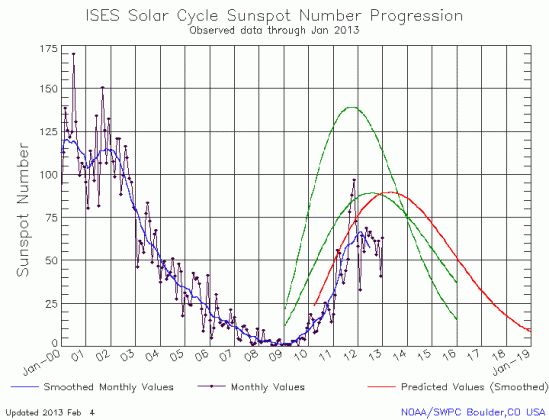The weak solar maximum continues
On February 4, NOAA released its monthly update of the Sun’s sunspot cycle, covering the period of January 2013. As I do every month, I have posted the latest graph, with annotation, below the fold.
Not surprisingly, the sunspot numbers in January showed a recovery and rise from the steep plunge in December. What is surprising, however, is that the rise is not very much, barely bringing the sunspot number for the month back to the weak numbers we’ve seen for most of 2012.

For reference, the green curves in the graph show the two original predictions of the solar scientist community from April 2007, with half the scientists predicting a very strong maximum and half predicting a weak one. The red curve is their revised May 2009 prediction.
Note also that for the first time in five months the solar scientists at the Marshall Space Flight Center have not changed their prediction for the upcoming solar maximum, holding to their prediction of a sunspot number at maximum of 69, occurring in the fall of 2013.
Despite these predictions, however, the January numbers once again suggest that we might have already seen solar maximum back in November 2011. And based on the up-and-down pattern of solar activity for the past few years, I would not be surprised it January’s rise is followed again by a drop in February. Above all, nothing the sun has been doing suggests that we will see a strong peak later this year.
Still, a solar maximum peak later this year could happen, as predicted. The simple fact remains, however, that we really don’t understand the magnetic field processes in the sun that produce the solar cycle, and that all the predictions so far about that solar cycle have therefore been nothing more than guesswork.
Should one prediction come true, however, it will bring with it some significant scientific discoveries as well as the possibility that the Earth’s climate will cool significantly. In 2011 the solar scientist community predicted that the sun’s prolonged the lack of sunspots these past few years has set the stage for another Grand Minimum, in which the sun will stop producing sunspots for decades and the 11-year solar cycle will more-or-less shut down.
Such a Grand Minimum has not happened since the 1600s. Should it happen now, it will give scientists a priceless opportunity to study a rare behavior of the sun, armed with today’s fleet of space telescopes and computer capabilities.
More important, it will give those same scientists a wonderful opportunity to find out just how much the sun really varies in output during such a minimum. When the sun last went through a grand minimum in the 1600s, dubbed the Maunder Minimum, the Earth experienced what has been called the Little Ice Age. The climate cooled so much during this time period that for some years, there was no summer, and there were crop failures that resulted in famine.
What remains unclear to scientists however is how much of this cooling was caused by an inactive sun. At the moment we simply don’t know. During the last few centuries scientists have measured the variations of the sun during its normal solar cycle and have found that the variations are simply not enough to account for such cooling. What happens in a Grand Minimum, however, is not known. The sun might dim more than we think.
Should another Grand Minimum take place over the next few decades, however, scientists will have a chance to find out. And they may discover that a bit of global warming might be a good thing, offsetting the cooling produced by an inactive sun.
On Christmas Eve 1968 three Americans became the first humans to visit another world. What they did to celebrate was unexpected and profound, and will be remembered throughout all human history. Genesis: the Story of Apollo 8, Robert Zimmerman's classic history of humanity's first journey to another world, tells that story, and it is now available as both an ebook and an audiobook, both with a foreword by Valerie Anders and a new introduction by Robert Zimmerman.
The print edition can be purchased at Amazon or from any other book seller. If you want an autographed copy the price is $60 for the hardback and $45 for the paperback, plus $8 shipping for each. Go here for purchasing details. The ebook is available everywhere for $5.99 (before discount) at amazon, or direct from my ebook publisher, ebookit. If you buy it from ebookit you don't support the big tech companies and the author gets a bigger cut much sooner.
The audiobook is also available at all these vendors, and is also free with a 30-day trial membership to Audible.
"Not simply about one mission, [Genesis] is also the history of America's quest for the moon... Zimmerman has done a masterful job of tying disparate events together into a solid account of one of America's greatest human triumphs."--San Antonio Express-News


The world is a tinder box of potential and actual conflict, perfect time for a mini ice age.
Let’s hope we’re not really headed for a big long term minimum!
Our weak solar activity is really caused by global warming.